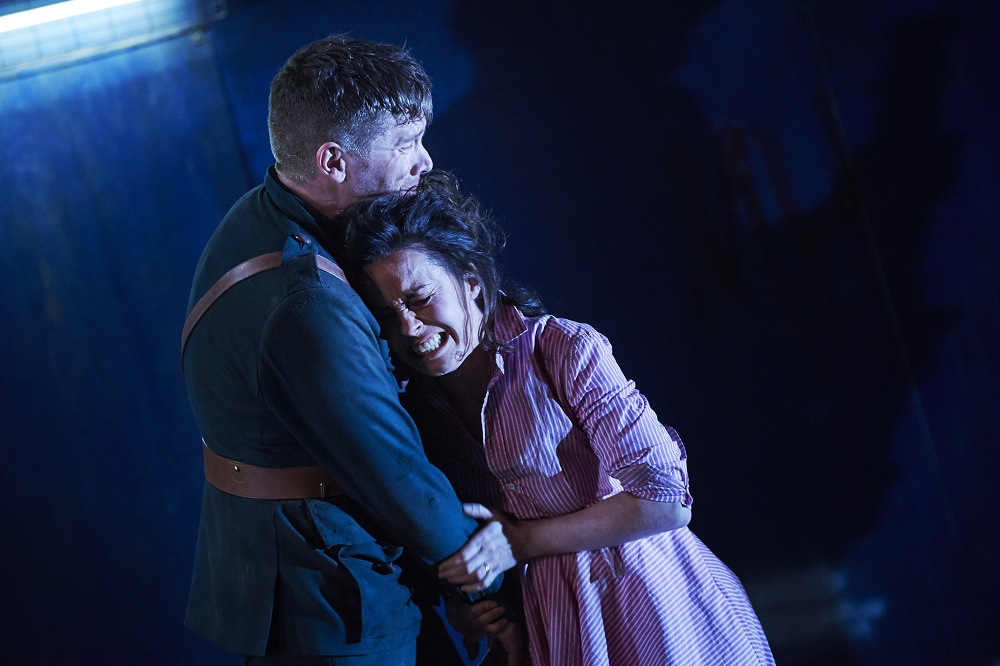Ireland’s National Theatre presents the Sean O’Casey play ‘The Plough and the Stars.’

Ireland’s Easter Rising was a rebellion that occurred during Easter week in April of 1916. The goal was to end British rule in Ireland. This historical event is at the center of The Plough and the Stars, but the play is much more personal than I was expecting. In the opening scene, a young girl, Mollser, (Rachel Gleeson) takes center stage and sings Ireland’s Nation Anthem, but halfway through her song, she begins coughing up blood.
Cut to a tenement apartment building in Dublin. Jack (Ian-Lloyd Anderson) is married to Nora, (Kate Stanley Brennan) and they live with her uncle and his cousin who have completely opposing political views and are always at each other’s throats.
The Plough and the Stars refers to the flag of the Irish Citizen Army (ICA). This green and yellow flag has stars in the shape of The Big Dipper. Jack gave up the ICA, but Nora says that’s more because he was passed over for a promotion, than out of respect for her wishes. Jack and Nora are in the middle of making love when Captain Brennan brings a message from the ICA’s General.
It seems that Jack was promoted to Commandant just recently, and is expected to lead a group that will assemble at the town meeting that night. Jack asks why he was not informed of this, but Captain Brennan says he was informed; a letter was delivered two weeks ago.
When Nora admits to burning the letter, Jack puts his uniform on quickly and goes with the Captain. On the way out the door, he tells Nora not to wait up for him, that he will be back very late. Nora shouts at his exiting form, “I don’t care if you never come back at all!”
But we see, very painfully, how much Nora really does care. Nora is the pivotal character in The Plough and the Stars. I was drawn to her and found her reflections on the vastly different attitudes that men and women have about war to be incredibly insightful.
In the next scene, Nora is pregnant, and being led home after being out looking for Jack. No one will tell her where he is and they mock her for being so bold as to go looking for him. She should be waiting patiently and heroically at home as all the other women do. What she is doing is a very bad influence on the soldiers.
Rebecca Campbell is the Program Assistant in the Office of Arts and Cultural Programming. She is also a Theater student who is researching The Plough and the Stars for her graduate program According to Campbell, “There was no protocol for how women were supposed to handle this particular situation and many had a hard time finding their place in it. The Plough and the Stars is showing a side that was mostly behind closed doors. This darkness, and the turning of the world on its side, created these powerful women who were going to fight in any way they could to get through their lives.”
In the show, Nora said that she knows that wherever Jack is, he is thinking of her and longing to be with her. “An’ he stands wherever he is because he’s brave? No, but because he’s a coward!” How can a brave soldier be a coward? Nora continued, “I tell you they’re afraid to say they’re afraid! Oh, I saw it, at th’ barricade in North King Street I saw fear glowin’ in all their eyes. An’ some o’ them laughed at me, but the’ laugh was a frightened one. An’ some o’ them shouted at me, but th’ shout had in it th’ shiver o’ fear. I tell you they were afraid!”
The ironic truth in this is unmistakable. What some call “bravery” is really just being afraid to admit you are afraid. If more soldiers would admit to being afraid, there would certainly be less war. To Campbell’s point, Act IV of The Plough and the Stars quite literally turns things on their side. The three-story metal fire escape structure that represented the tenement building is tipped over while the audience watches and the actors use the long topside as the set for the last scene.
It is in this scene that we also see Mollser’s coffin. She represents the people who die of diseases, like consumption, due to poor living conditions. These kinds of needless deaths, greatly outnumber the deaths from war, we are told.
The characters in The Plough and the Stars speak very quickly at times, and with Irish accents, it can be difficult understand all of what is being said. But their message, nonetheless, rings loud and clear.

You must be logged in to post a comment Login